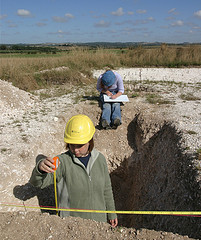As part of my work with Aquent, I interviewed a number of the many talented people who work for that company. I posted these interviews as a way of spotlighting the aforementioned talent. This interview with web designer Jon Billett first appeared on February 12, 2009.
 Jon Billett is a designer represented by Aquent’s Philadelphia office who has spent the last several years making the transition from print to web. Of the work he’s done that you may have seen are a set of banner ads featuring Regis and Kelly which Jon created for TD Bank.
Jon Billett is a designer represented by Aquent’s Philadelphia office who has spent the last several years making the transition from print to web. Of the work he’s done that you may have seen are a set of banner ads featuring Regis and Kelly which Jon created for TD Bank.
I asked Jon a few questions about his career, the process of moving from print design to interactive design, and the key to creating effective banner ads. Here’s what he told me.
You started your career as a graphic designer, right?
Yep, my background is in print design. It’s what I studied in school and it’s what gave me my foundation in layout, aesthetics, and making things look pretty.
So how did you build your interactive chops?
After I graduated, I basically taught myself at first and then networked with as many people as I could to learn from them. I made an online Flash portfolio and was fortunate enough to land a job through Craigslist with 3601, the internal ad agency at the Wachovia Center here in Philly.
What sort of stuff did you do with 3601??
This was back in 2006 and they really hadn’t done too much Flash or web stuff themselves, so they hired me to create banner ads, put together the web site for the agency, and things like that. I also worked on the design of the iWalls that they have installed there. These huge displays allow fans to interact with hi-def timelines dedicated to the Flyers and the Sixers. It’s really great to see people on TV playing with them, and being a fan myself, I had a lot of fun creating them.
Was it challenging to be “the web guy” on the team?
In a way. I was the only person who knew how to do this stuff, so when I had problems, there wasn’t anyone in the office that I could turn to. I had to reach out and find other sources to get answers.
What sources did you find?
I got a lot of help from TechnicalLead.com, which also runs LearnFlash.com. I joined as a member so I could have access to their tutorial videos but the best part of the service was access to mentors – experts who have really mastered this technology. Having a specific person you can tap for help is ideal, though you really need to be at a certain level to make the most of mentoring.
I realize that banner ads are just part of what you’ve done, but what would you say is the key to a successful banner ad design?
A banner ad can’t be distracting, but it still has to attract attention and be intriguing. You have to put enough in the ad to pique someone’s curiosity and get them to click without making it too busy (and not just because you want to keep the file sizes down). Aside from making the ads entertaining and engaging, I like using the format to throw in new animation tricks I’ve learned.
Last question. Who are your influences?
On the print side, I would say that my biggest influences have been Saul Bass, David Carson, with his “type as image” stuff, and street/urban things like Shephard Fairey. On the web front, I absolutely love the work being done by AYC Media.
 The other day I posted, “5 Rules for Creating Content that RULES!“, which I wrote with PJA’s Mike O’Toole. We were walking a fine line because we wanted to talk about ways to effectively conduct content-driven marketing but, at the same time, we said that your content strategy had to flow from your marketing strategy AND that content itself, in order to be useful and ultimately shareable, had to be created with the audience in mind.
The other day I posted, “5 Rules for Creating Content that RULES!“, which I wrote with PJA’s Mike O’Toole. We were walking a fine line because we wanted to talk about ways to effectively conduct content-driven marketing but, at the same time, we said that your content strategy had to flow from your marketing strategy AND that content itself, in order to be useful and ultimately shareable, had to be created with the audience in mind.

 Minh Nguyen, a Southern California-based web designer currently working for Sony Electronics, has been represented by our San Diego office for a little over a year.
Minh Nguyen, a Southern California-based web designer currently working for Sony Electronics, has been represented by our San Diego office for a little over a year.
